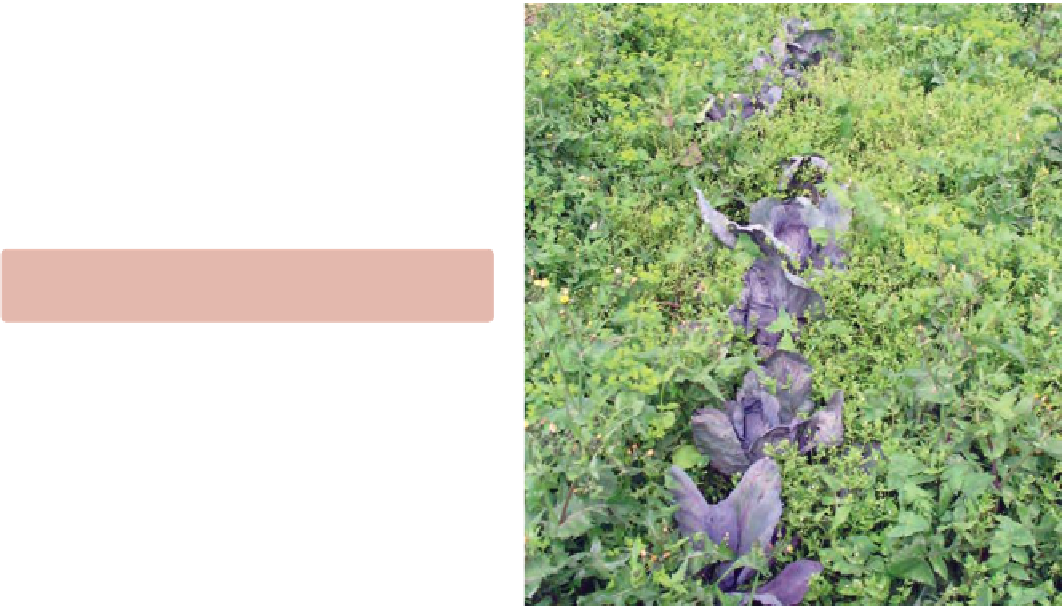Agriculture Reference
In-Depth Information
Introduction
This chapter gives an overview of weeds and their
importance in private gardens. A representative
range of weed species is described to cover most
horticultural locations. Non-chemical and chemical
controls are discussed.
Control measures and their impact on humans and the
environment are dealt with in more detail in Chapter 16.
A
weed
is a plant of any kind that is growing in
the wrong place.
Damage
Problems caused by weeds may be categorized as
follows:
X
Reduction of crop productivity
occurs because
of competition between the weed and the plant
for water, nutrients and light. The cultivated plants
are deprived of these major requirements and poor
growth results. The extent of this competition is
largely unpredictable. The major effects are seen
when
light
is excluded from the garden plants
as they are crowded out by the weeds. Similarly,
the availability of
nutrients
and
water
becomes
restricted when the weeds out-compete the
garden plants.
X
Ephemeral
weeds crop productivity is further
reduced when large numbers of seeds
such
as hairy bittercress (
Cardamine hirsuta
) and
shepherd's purse (
Capsella bursa-pastoris
),
chickweed (
Stellaria media
) and groundsel (
Senecio
vulgaris
) may be
introduced
into a cultivated soil
with poor-quality composts or farmyard manure.
X
Annual
weeds, such as fi eld speedwell (
Veronica
persica
) and annual meadow grass (
Poa annua
),
may also be introduced in this way.
X
Perennial
weed seeds are not normally introduced
in such large amounts in poor compost. However,
their underground organs in such species as
creeping buttercup (
Ranunculus repens
), ground
elder (
Aegopodium podograria
), couch (
Agropyron
repens
) and creeping thistle (
Cirsium arvense
)
may survive poor composting (see compost
temperature p. 161).
X
Uncontrolled growth
of many weeds will
inevitably produce serious plant losses (Figure 17.2).
Figure 17.2
Chickweed and sow thistle crowding out
a cabbage crop
the growth of garden plants themselves may not
be badly affected. Bindweed growing up shrubs
and ground elder sprouting from beneath concrete
garden paths are two examples of this kind of effect.
X
Alternate hosts of pests and diseases
.
Horticultural pests and diseases are quite commonly
found on weeds. Sow thistle and chickweed
often support whitefl y and red spider mite in
greenhouses. Groundsel is infected by a rust
disease that attacks cinerarias (see also p. 194).
X
Other weed effects
.
Weeds may affect
drainage
by preventing the fl ow of water along ditches (e.g.
by chickweed). Weeds such as redshank that have
strong stringy stems may clog mowing
machines
(Figure 17.3). Shiny dark-coloured
poisonous
fruits
of the climbing black nightshade may be confused
with blackcurrant fruits.
Weeds in different garden locations
Four main garden situations are listed below, together
with some weeds that are commonly found in them.
X
In
recently cultivated soil
,
the seeds of
ephemeral and annual weeds such as chickweed
and common speedwell, which have been brought
to the soil surface, often germinate in large
numbers. A common perennial weed problem in
this location is couch grass.
X
Reduced visual appeal of plants in a garden
. This
is another way that weeds affect the garden. The
conscientious gardener may consider that any plant
spoiling the appearance of plants in pots, borders,
paths or lawns should be removed, even though

